Technical Sciences Paper 1 Grade 12 Questions - NSC Past Papers And Memos September 2020 Preparatory Examinations
Share via Whatsapp Join our WhatsApp Group Join our Telegram GroupINSTRUCTIONS AND INFORMATION
- Write your FULL NAME and SURNAME in the appropriate spaces on the ANSWER BOOK.
- This question paper consists of EIGHT questions. Answer ALL the questions in the ANSWER BOOK.
- Start each question on a NEW page in the ANSWER BOOK.
- Number the answers correctly according to the numbering system used in this question paper.
- Leave ONE line between two subquestions, e.g. between QUESTION 2.1 and QUESTION 2.2.
- You may use a non-programmable calculator.
- You may use appropriate mathematical instruments.
- You are advised to use the attached DATA SHEETS.
- Show ALL formulae and substitutions in ALL calculations.
- Round off your FINAL numerical answers to a minimum of TWO decimal places.
- Give brief motivations, discussions, etc. where required.
- Write neatly and legibly.
QUESTIONS
QUESTION 1: MULTIPLE-CHOICE QUESTIONS
Various options are provided as possible answers to the following questions. Choose the answer and write only the letter (A–D) next to the question numbers (1.1–1.10) in the ANSWER BOOK, for example 1.11 D.
1.1 A bag is placed on a frictionless floor in a bus travelling due west at a constant velocity. When the bus stops suddenly, the bag will ...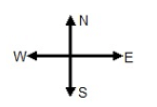
- not move.
- move due east.
- move due west.
- move due south. (2)
1.2 Which ONE of the following is always in the same direction as the acceleration of a body?
- Velocity
- Work done
- Momentum
- Rate of change of momentum (2)
1.3 A block of mass m pulled over a frictionless surface with a force of F has an acceleration of a m.s-2.
What would be the magnitude of the force required to accelerate a block of mass 2m at a m.s-2?
- ½F
- F
- 2F
- 3F (2)
1.4 Two blocks, P and Q, initially at rest, have a spring compressed between them. The spring is released and the blocks move away from each other. IGNORE FRICTION.
The magnitude of the momentum of block P after the spring is released is x kg.m.s-1.
Which ONE of the following CORRECTLY gives the total momentum of the system, before the spring is released and the momentum of block Q after the spring is released?
Total momentum of the system before the spring is released | Momentum of block Q after the spring is released | |
A | 0 | x due east |
B | x due west | 0 |
C | x due east | x due west |
D | 0 | x due west |
(2)
1.5 The work done to move an object over a distance by a force F which is applied 60° to the horizontal is W.
The work done to move the object through the same distance by the force F acting horizontally to the surface is …
- ½W.
- W.
- 2W.
- 3W. (2)
1.6 Consider the following statements regarding fluid pressure:
- Fluid pressure is directly proportional to the depth
- Fluid pressure is independent of the size or shape of the container
- Fluid pressure is inversely proportional to the density of the fluid
Which ONE of the following is CORRECT regarding fluid pressure?
- (i) and (ii)
- (ii) and (iii)
- (i) and (iii)
- (i), (ii) and (iii) (2)
1.7 A force, which changes the shape and size of a body, is … force.
- normal
- frictional
- restoring
- deforming (2)
1.8 The maximum force that can be applied on a body so that the body regains its original form completely on removal of the force is …
- strain.
- stress.
- tension.
- elastic limit. (2)
1.9 The equivalent unit of Farad (F) is …
- C∙V.
- C∙V-1.
- C∙V-2.
- C∙V2. (2)
1.10 In the circuit given below the resistance of Y is twice that of X.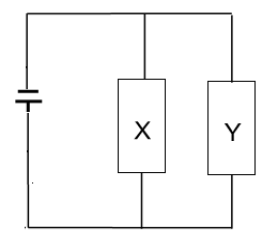
If the current in X is 1 A, then the current in Y will be …
- ½ A.
- 1 A.
- 2 A.
- 4 A. (2)
[20]
QUESTION 2 (Start on a new page.)
A block is pulled over a rough surface XY by means of a force F. The block moves at a constant velocity of 5 m.s-1 along part XY.
When the block moves past Y the force F is removed.
Part YZ is frictionless.
2.1 Draw a free body diagram of all the forces acting on the block when the block is on part YZ. (2)
2.2 State Newton’s first law of motion in words. (2)
2.3 Describe the motion of the block on part YZ. (2)
[6]
QUESTION 3 (Start on a new page.)
Two blocks of masses 30 kg and 20 kg connected by a light inextensible string are pulled along a rough surface by force F, applied at an angle 30° to the horizontal.
The tension T on the string is 50 N and coefficient of kinetic friction is 0,2 for both blocks.
Assume that the system is isolated.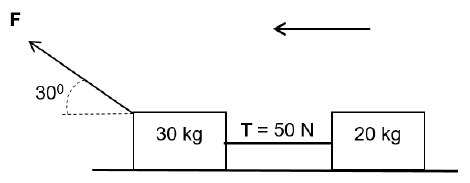
3.1 State Newton’s second law of motion in words. (2)
3.2 Define the term isolated system. (2)
3.3 Draw the free body diagram of all the forces acting on the 30 kg block. (5)
3.4 Calculate the:
3.4.1 Acceleration of the blocks. (4)
3.4.2 Magnitude of force F that is applied on the 30 kg block. (5)
3.5 Force F is now applied downward on the 30 kg block at an angle 30° to the horizontal as shown in the diagram.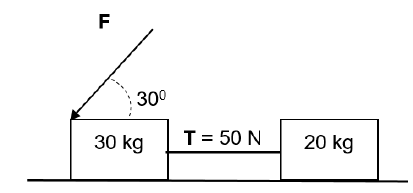
How would the following quantities change?
(State INCREASES, DECREASES or REMAINS THE SAME.)
3.5.1 Acceleration of the system (1)
3.5.2 Tension T on the string (1)
3.6 Explain the answer to QUESTION 3.5.1. (2)
[22]
QUESTION 4 (Start on a new page.)
A 5 kg block moving due east with a velocity of 4 m∙s-1 collides with a stationary 3 kg block.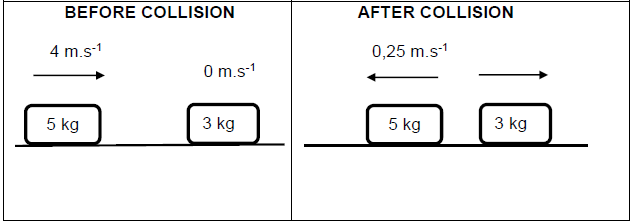
Immediately after the collision, the 5 kg block moves due west with a velocity of 0,25 m.s-1 and the 3 kg block moves with a constant velocity due east as shown in the diagram below.
The collision is inelastic.
4.1 Define the term momentum. (2)
4.2 Which quantity (MOMENTUM or KINETIC ENERGY) is conserved during this collision? (1)
4.3 Calculate the velocity of the 3 kg block after collision. (4)
4.4 Name and state the law used in the calculation in QUESTION 4.3 above. (3)
[10]
QUESTION 5 (Start on a new page.)
A car with a mass of 1 000 kg travelling due east, collides head-on with a truck with a mass of 5 000 kg moving at 20 m·s-1 due west. The force exerted by the truck on the car during the collision is 100 000 N and the collision lasts for 0,4 s.
After the collision, the car and the truck move together. Ignore the effects of friction.
5.1 What is the magnitude and direction of the force exerted by the car on the truck during the collision? (2)
5.2 Name and state the law used to answer QUESTION 5.1 above. (3)
5.3 Define the term impulse. (2)
5.4 Calculate the velocity of the car after the collision. (4)
[11]
QUESTION 6 (Start on a new page.)
6.1 A crate of bricks with a mass of 50 kg is lifted up by a motor which is placed at the top of a building as shown in the diagram. The force exerted by the motor is F and the block moves upward with a constant velocity of 5 m.s-1.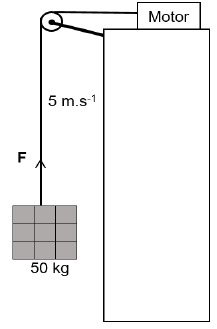
6.1.1 Define the term work. (2)
6.1.2 Name all the forces acting on the crate of bricks. (2)
6.1.3 What is the net force acting on the crate of bricks? Give a reason for your answer. (2)
6.1.4 Calculate the power generated by the motor. (4)
6.2 A brick with a mass of 0,5 kg is thrown downwards with a velocity of 10 m.s-1 from height h metres above the ground. When the brick is ⅔h metres above the ground, its velocity is 20,34 m.s-1. (IGNORE AIR FRICTION.)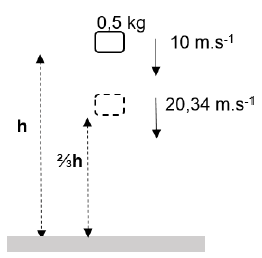
6.2.1 State the law of conservation of mechanical energy. (2)
6.2.2 Calculate the mechanical energy of the brick. (6)
6.2.3 Calculate the velocity of the brick just before it touches the ground. (3)
6.3 An object of mass 20 kg is pulled along a straight horizontal road to the right without being lifted. The force diagram below shows all the forces acting on the object.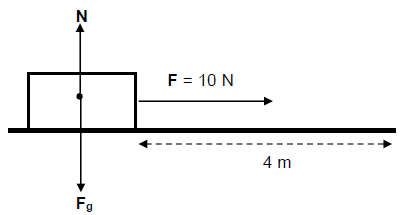
The applied force F is 10 N and the object is displaced through a distance of 4 m.
6.3.1 What is the value of the work done by the normal force (N)? Explain. (3)
6.3.2 Calculate the work done by force F. (3)
[27]
QUESTION 7 (Start on a new page.)
7.1 What is a perfectly elastic body? (2)
7.2 Define the term stress. (2)
7.3 A stress vs strain graph for steel and tungsten is given below.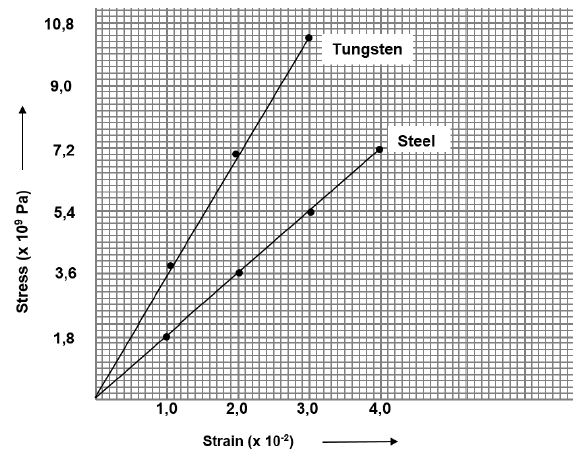
Answer the following questions using the above graph.
7.3.1 Write down the relationship between stress and strain. (2)
7.3.2 Write down the name of the law that states the above relationship between stress and strain. (1)
7.3.3 Which ONE of the materials has the highest modulus of elasticity? Explain. (2)
7.3.4 Calculate the modulus of elasticity of steel. (3)
7.4 The viscosity of three different substances at 25 °C are given in the table below.
Substance | Viscosity (Pa.s) |
Water | 8,94 x 10-4 |
Blood | 3,5 x 10-3 |
Motor oil SAE 10 | 6,5 x 10-2 |
7.4.1 Define viscosity. (2)
7.4.2 Which ONE of the above substances flows the fastest? Explain your answer. (2)
7.4.3 How does the increase in temperature affect the viscosity? (2)
7.5 A simple diagram of hydraulic brakes is given below. The area of piston A is 284 × 10-6 m2 and piston B is 507 × 10-6 m2. The force applied on the brake pedal is 1 765 N.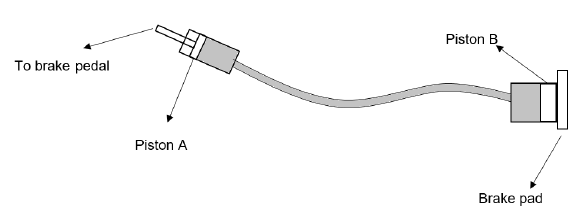
7.5.1 State Pascal’s law in words. (2)
7.5.2 Calculate the force exerted by piston B on the brake pad. (4)
7.5.3 What would happen to the pressure on the brake pad if the area of piston B is increased? (1)
Write down only INCREASES, DECREASES or REMAINS THE SAME
7.5.4 Write down TWO uses of hydraulic systems other than hydraulic brakes. (2)
[27]
QUESTION 8 (Start on a new page.)
8.1 Semiconductor Ge is doped with the element phosphorus (P).
8.1.1 What is doping? (2)
8.1.2 What is the number of valence electrons in phosphorus? (1)
8.1.3 What type (n-type or p-type) of semiconductor is produced in the above process? (2)
8.1.4 What is the difference between n-type and p-type material? (2)
8.2 Each plate of a parallel plate capacitor has an area of 10 cm2. The plates are separated by a distance of 1 cm, with air occupying the space between the plates. The capacitor is connected to a 12 V DC supply.
8.2.1 Calculate the magnitude of charge on each plate. (6)
8.2.2 What is the net charge on the capacitor? (1)
8.2.3 Name TWO factors that can affect the capacitance of a capacitor. (2)
8.3 An electric kettle with resistance 26 Ω and a microwave oven with resistance 52 Ω are connected in parallel and the combination is connected across a source of voltage 230 V as shown in the diagram.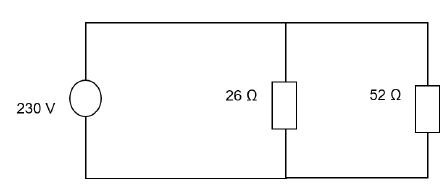
8.3.1 Define power. (2)
8.3.2 Calculate the total resistance of the circuit. (3)
8.3.3 Calculate the power developed across the electric kettle. (3)
8.3.4 How much heat is produced in the electric kettle in 2 minutes? (3)
[27]
TOTAL: 150
DATA FOR TECHNICAL SCIENCES GRADE 12
PAPER 1
TABLE 1: PHYSICAL CONSTANTS
| NAME | SYMBOL | VALUE |
| Acceleration due to gravity | g | 9,8 m·s-2 |
| Coulomb's constant | k | 9,0 x 109 N·m2·C-2 |
| Permittivity of free space | ε0 | 8,85 x 10-12 F.m-1 |
TABLE 2: FORMULAE
FORCE
WORK, ENERGY AND POWER
ELASTICITY, VISCOSITY AND HYDRAULICS
ELECTROSTATICS
CURRENT ELECTRICITY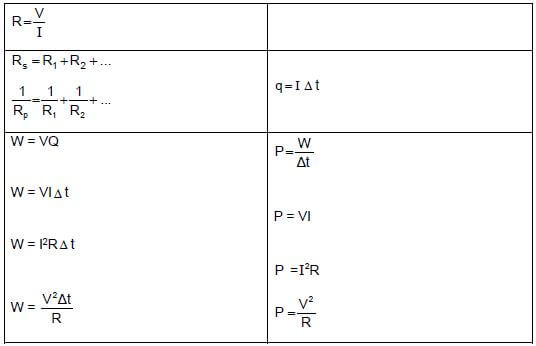
ELECTROMAGNETISM